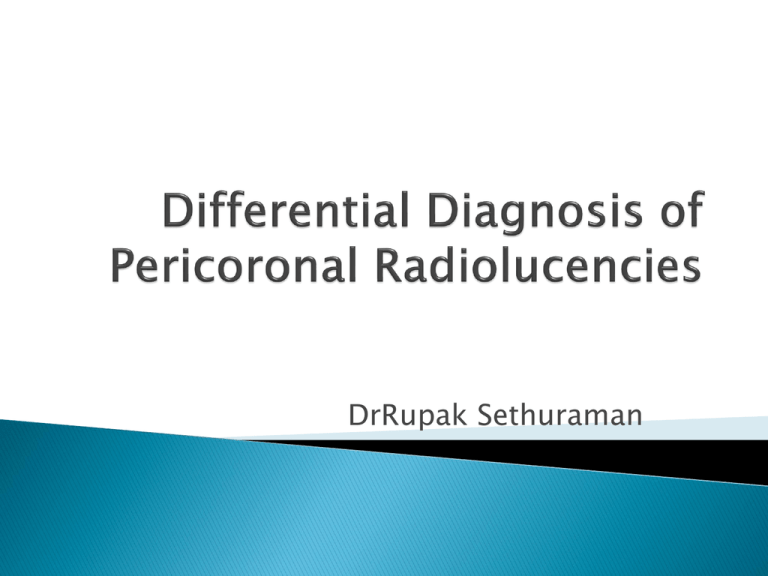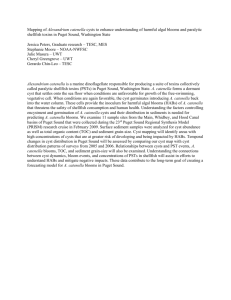Differential Diagnosis of Pericoronal Radiolucencies
advertisement

DrRupak Sethuraman Introduction Classification Differential Diagnosis Radiographic Techniques Conclusion To know the classification of pericoronal radiolucencies. To know the differences between each of the pericoronal radiolucencies. Advice of relevant radiographs to achieve a diagnosis. Pericoronal radiolucencies comprise those lesions which cause radiolucency in the coronal region of the tooth or teeth. The teeth are usually not erupted or may be clinically as covered by the cystic fluid under the overlying mucosa. 1. 2. 3. 4. Dentigerous cyst Odontogenic keratocyst Paradental cyst Eruption Cyst DENTIGEROUS CYST: (Synonym - Follicular cyst) Definition: It can be defined as an odontogenic cyst that surrounds the crown of an impacted tooth. It is estimated that about 10% of impacted teeth have formed a dentigerous cyst. Pathogenesis: It is uncertain but apparently it develops by accumulation of fluid between the reduced enamel epithelium and enamel surface resulting in a cyst in which crown is located within the lumen. Clinical features: 10- 50yrs (Peak 2nd decade) Male predilection. Commonly involve: Mandibular molars, Maxillary Canines, Maxillary Molars, Supernumerary teeth. The cyst is always associated with crown of an impacted, embedded or unerupted tooth. Most of them are Solitary. Bilateral or multiple are in association with Cleidocranial dysplasia and Maroteaux-lamy syndrome. Expansion of bone with subsequent facial asymmetry Displacement of teeth, Root resorption of adjacent teeth and pain are subsequent sequelae (steps) of continuous enlargement. Displacement of third molar such that it comes to lie compressed against the inferior border of the mandible. In case of a cyst associated with a maxillary cuspid, expansion of anterior maxilla often occurs and resemble acute sinusitis or cellulitis. Location: Epicenter above the crown of the involved tooth Attached at Cemento enamel junction Well corticated Margins Little tendency towards scalloping Unicystic, some are multilocular Periphery and shape Dentigerous cysts typically have well-defined cortex with a curved or circular outline. If infection is present, the cortex may be missing. Internal structure The internal aspect is completely radiolucent except for the crown of the involved tooth. The circumferential dentigerous cyst appears to erupt through the cyst as “through the hole in a doughnut” The lateral dentigerous cyst occurs on one side of the involved tooth. Differential diagnosis: o Ameloblastoma – o soap bubble appearance o Causes root resorption. o Calcifying Odontogenic Cyst o Common in maxilla, cortical plate perforation o Adenomatoid odontontogenic tumor o Anterior maxillary teeth, root divergence o Cystic lining does not arise from CEJ o Odontogenic Keratocyst o Mandibular ramus third molar region. o Delayed Expansion so diagnosed very late. Potential complications: o Epidermoid carcinoma o Mucoepidermoid carcinoma o Mural Ameloblastoma Management: -Small lesions can be surgically removed. -Large cysts are often treated by surgical drainage or marsupialization. Definition: A cyst derived from the remnants of the dental lamina, with a biologic behavior similar to a benign neoplasm, with a distinctive lining of 6-10 cells in thickness & exhibits a basal cell layer of palisaded cells & a surface of corrugated parakeratin. It is named keratocyst because cyst epithelium produces so much keratin that it fills the cystic lumen. Keratocystic odontogenic Tumor Oral Oncology (2007) 43, 619– 620 Epithelium lining the OKC has innate growth potential, as in a benign tumor. This difference in the mechanism of growth gives OKCs a different radiographic appearance. Islands of epithelium in the connective tissue may give rise to satellite microcysts. -They occur in a wide age range, but most develop during the second and third decades, -Slight male predilection. -Common site : Mandibular ramus third molar region -Asymptomatic, although mild swelling may occur. -No obvious swelling seen in these cases. -Rarely paresthesia is noted. -Pain may occur with secondary infection. -Aspiration may reveal a thick, yellow, cheesy material (keratin) -High propensity recurrence. for Location -Posterior body of the mandible (90% occur posterior to the canines) and ramus (more than 50%). -The epicenter is located superior to the inferior alveolar nerve canal. Periphery and shape: -Well corticated border unless they have become secondarily infected. -Smooth round or oval shape identical to that of other cysts, or it may have a scalloped outline. Internal structure: -Radiolucent. -Some cases curved internal septa – multilocular appearance. Effects on surrounding structures -Propensity to grow along the internal aspect of the jaws, causing minimal expansion. -This occurs throughout the mandible except for the upper ramus and coronoid process, where considerable expansion may occur. -OKCs can displace and resorb teeth but to a slightly lesser degree than dentigerous cysts. -The inferior alveolar nerve canal may be displaced, inferiorly. -In the maxilla this cyst can invaginate and occupy the entire maxillary antrum. Management: Surgical excision is the treatment of choice. Marsupialization Enucleation and primary closure Enucleation and packing open Differential diagnosis: o Dentigerous cyst o Ameloblastoma o Residual cyst o Traumatic bone cyst – o o More scalloped and very thin borders, covers more than one tooth. Is anterior in location. Associated with partially impacted 3rd molars Result of inflammation of the gingiva over an erupting molar 0.5 to 4% of cysts. Clinical Features – The involved region shows a slightly erupting third molar, where a part of cusp can be seen. Probe can usually pass through the distal extent of the third molar into the cystic lumen. Cystic lumen is not totally covered as in other cysts. Radiology – radiolucency seen in the distal aspect of the tooth with a well defined cystic lining. Cyst usually covers a part of the crown portion and not necessarily starts Differential Diagnosis – 1. Dentigerous Cyst from the CEJ. Treatment Enucleation 2. Residual Cyst – especially after extraction of third molar. – 3. Radicular cyst 4. Lateral Periodontal Cyst It is a form of dentigerous cyst associated with erupting deciduous /permanent teeth in children. Clinical features: These cysts are found in children of different ages and occasionally in adults if there is delayed eruption. Deciduous and permanent teeth are involved frequently anterior to permanent first molar. It appears as a circumscribed fluctuant often translucent swelling of the alveolar ridge over the site of eruption of the teeth. When the cystic cavity contains blood the swelling appears purple or deep blue hence it is called ‘Eruption hematoma. Radiographic features: o It may show soft tissue shadow and usually there is no bone involvement. o In some cases saucer shape excavation of bone projecting into cavity. Treatment: No treatment is necessary as the cyst often ruptures spontaneously. Surgically, exposing the crown of tooth may aid the eruption process. Any Questions?




